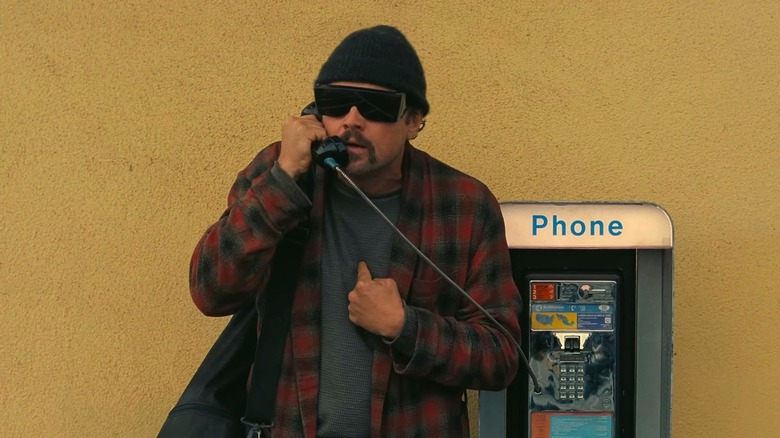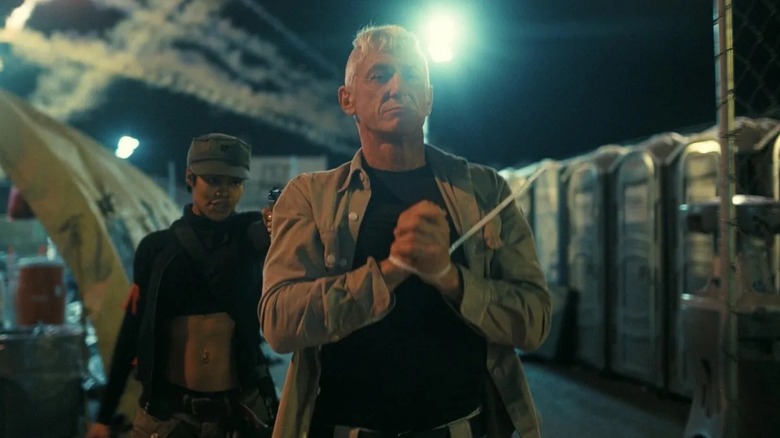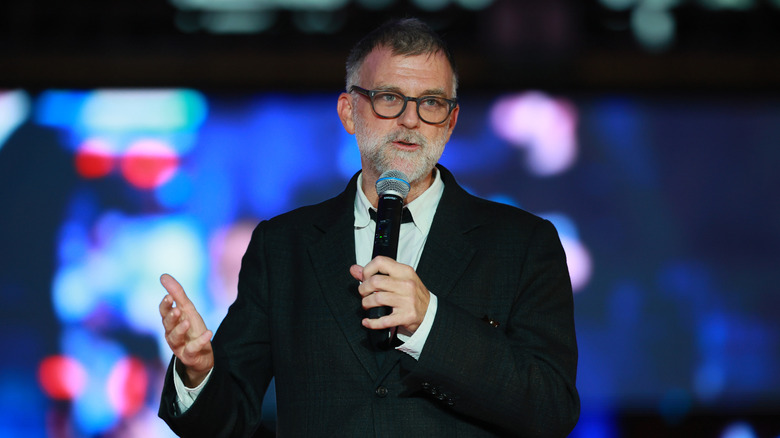Why One Battle After Another Bombed At The Box Office
One of the year's best-reviewed movies, Paul Thomas Anderson's "One Battle After Another" has been acclaimed as a stirring triumph that dares to confront the modern world with incredible performances. Unfortunately, like countless other weighty classics, "One Battle After Another" wasn't a box office champion. On its opening weekend, the title only grossed $22 million, marking "Battle" as one of star Leonardo DiCaprio's lowest theatrical debuts, coming in beneath the bows of "Killers of the Flower Moon" and "The Departed." All hopes of the immense pre-release critical hype and Warner Brothers's great box office year catapulting "One Battle After Another" to unexpectedly massive numbers went unrealized.
Thankfully, the film itself remains beloved, and that's unlikely to change anytime soon. But what happened to "One Battle After Another" that kept it from breaking out with general audiences? In fact, several factors negatively impacted the feature's box office potential, such as the demographic that showed up to its opening weekend, the film's marketing campaign, Anderson's lack of notoriety to the mainstream public, and "Battle's" towering budget, among other elements.
Despite the rampant acclaim greeting "One Battle After Another's" debut, there was also clearly a lot surrounding its theatrical release that just didn't click. Read on to discover why "One Battle After Another" bombed at the box office, even despite its rapturous reviews.
Skewed heavily male
When the dust settled on "One Battle After Another's" opening weekend, it was revealed that 64% of the film's audience were men. That statistic, combined with 50% also being Caucasian, reflected why "Battle" didn't break out of its pre-release tracking. In the 2020s, the biggest movies have been heavily driven by women. "Inside Out 2," "Barbie," "Taylor Swift: The Eras Tour," "Lilo & Stitch," and "Beetlejuice Beetlejuice" were all primarily driven by female moviegoers. Even "Top Gun: Maverick's" record-shattering debut had 42% of its ticket sales come from lady patrons. If you want a theatrical release to go the financial distance in the 2020s, scoring support from women is paramount.
"One Battle After Another" is a mother/daughter story at its core, as illustrated by who the film centers on for its first and final shots. However, that didn't come through in the marketing, where Leonardo DiCaprio's gigantic face was front and center and the mother/daughter angle was rarely referenced. Combine all that with external factors like women growing increasingly disillusioned with DiCaprio's womanizer star persona, and it's no wonder "One Battle After Another" struggled to secure this critical demographic.
Without those audiences, there was only so high the feature could soar. If "One Battle After Another" proved anything, it's the essential role women play in 2020s biggest box office hits.
Overly mysterious marketing
At CinemaCon 2025, the annual gathering of movie theater owners, Warner Bros. brought out Leonardo DiCaprio, Regina Hall, and Teyana Taylor to hype up "One Battle After Another." However, the trio remained vague about their characters' relationships, as well as what "Battle" was even about. The only footage shown was an out-of-context clip depicting DiCaprio's Bob Ferguson at a pay phone frantically trying to locate his kidnapped daughter. It wasn't the greatest presentation and epitomized the overly mysterious approach to the entire "One Battle After Another" marketing campaign, which kept details about the feature and its searing political commentary under wraps.
As major media outlets have observed, marketing a film as intricate as "One Battle After Another" would be challenging in the best of times. The secretive DiCaprio-centric tactic wasn't the worst idea on paper, but it ultimately failed to give audiences much to latch onto. In contrast to the trailers for Warner Brothers' other 2025 original auteur-driven blockbuster "Sinners," that clearly defined the relationship between the villainous vampire and juke joint heroes without giving away the film's joys, "One Battle After Another's" advertising kept things frustratingly vague.
Without a definitive plot to cling to, this non-sequel proved impenetrable to general audiences. Much like the lack of women moviegoers, this shortcoming, which was even apparent back at its early CinemaCon showing, ensured a firm ceiling for "One Battle After Another's" box office haul.
No big supporting actors
Leonardo DiCaprio's biggest movies often see him alongside major actors that audiences equally anticipate. "Once Upon a Time in...Hollywood" was sold as a DiCaprio/Pitt two-hander, while "The Departed" surrounded him with Matt Damon and Jack Nicholson, and DiCaprio's Frank W. Abagnale contended with Tom Hanks in "Catch Me if You Can." Meanwhile, while the cast of "One Battle After Another" contains proven box office talent like Regina Hall, who has grossed over $1.4 billion domestically with hits like "Scary Movie" and "Girl's Trip" under her belt, the film's severe sidelining of her in both its narrative and marketing failed to make the impact it could have.
That only other recognizable name in the main cast with significant screen time is Sean Penn. Though he's been in the industry for decades, Penn's only appeared in one live-action movie, "Mystic River," that barely passed $90 million domestically. This reality meant that "One Battle After Another" had one less element to lean on to attract audiences. Granted, it's doubtful that shoehorning Timothee Chalamet into the film would've significantly boosted its financial performance.
Still, DiCaprio's biggest hits tend to come when he's interacting with big players like Jonah Hill or Daniel Day-Lewis. With Sean Penn being the closest thing to an equivalent in "One Battle After Another," the film's box office suffered accordingly.
Paul Thomas Anderson isn't a household name
Paul Thomas Anderson is a cinematic mastermind, whose created glorious visions exploring a wide range of lives and aesthetics. The harsh truth, unfortunately, is that he's also not a household name. While not a reflection of the quality of his work, it's hard to deny that his titles are challenging and rarely fall into crowdpleaser molds (see: "The Master," "Punch-Drunk Love"). Only one of his features prior to "Battle," the 2007 Oscar darling "There Will Be Blood," exceeded $27 million domestically. Much of his work, including three of the four movies directly preceding "One Battle After Another," failed to clear $20+ million in North America.
Much of the advertising for "One Battle After Another" leaned on Anderson's legacy, emphasizing the man's name on posters and trailers. For the majority of audiences, though, that name has no connotation, either positive or negative. Compare that to folks like Jordan Peele, Christopher Nolan, or Quentin Tarantino, who have the pull to get butts in seats no matter what they've dished up. Anderson just isn't in the same league as those directors in terms of universal recognition, having not helmed any mainstream genre films.
Anderson's creative chops endlessly benefited "One Battle After Another" as a piece of art. However, his name wasn't enough to make any kind of difference in the film's domestic opening weekend.
That gigantic budget
While far from a breakout hit, "One Battle After Another's" debuted in line with other adult-skewing dramas that opened in September. Titles like "Prisoners," "Contagion," "Black Mass," and "The Town," all bowed in the $20-23.8 million range in North America. However, those other films cost considerably less than "Battle." While "The Town" cost $37 million to make, "One Battle After Another" had a $135 million budget. That makes it not only Paul Thomas Anderson's most expensive directorial effort by a massive margin, but ensured that theatrical profitability would be a long shot for this title.
To break even, "Battle" would've needed to exceed $300+ million worldwide, a threshold that even Quentin Tarantino has only cleared three times in his career. Heck, excluding "Titanic" and "Inception," DiCaprio's only headlined six movies that have cleared $300+ million. "One Battle After Another" would've had to shatter many box office norms to not lose money, tremendous pressure to put on a film adaptation of a Thomas Pynchon novel released in the tumultuous 2020s theatrical landscape.
Every penny spent on "One Battle After Another" certainly shows on screen. However, that gigantic budget also guaranteed that "Battle's" war for theatrical profitability was over before it even started.





![A pregnant Perfidia Beverly Hills firing off a gun in One Battle After Another ]](https://www.looper.com/img/gallery/why-one-battle-after-another-bombed-at-the-box-office/that-gigantic-budget-1760635917.jpg)